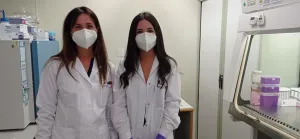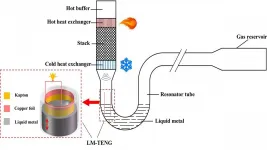Pumping the 'brain brake' in pediatric anxiety
UC researchers find ways to predict treatment outcomes for adolescent anxiety using brain imaging
2021-03-31
(Press-News.org) As with any complex machine, sometimes a simple crossed wire or short circuit can cause problems with how it functions. The same goes for our brains, and even when the short circuit is uncovered, sometimes experts don't have a quick fix.
A new study reveals that an evidence-based treatment may "fix" this human short circuit and, with the help of brain imaging, might predict treatment outcomes for adolescents with anxiety disorders. University of Cincinnati researchers say this could determine medication effectiveness more quickly to help patients.
Study results showed that brain imaging was able to predict -- after just two weeks of treatment with almost 80% accuracy -- how much a patient would improve.
"We also see [through imaging] that the medication in this study increases the strength of the connection between a brain area that generates anxiety and an area that serves as a 'brain brake' for the fear center," says Jeffrey Strawn, MD, associate professor and anxiety expert in the Department of Psychiatry and Behavioral Neuroscience at UC, who is the senior author on this study. "In essence, the medication allows the brain to dampen the overactivity of fear areas, and we see this dampening very early in the course of treatment using imaging."
In this National Institutes of Health-sponsored study, published in the Journal of the American Academy of Child and Adolescent Psychiatry, researchers used brain imaging (MRI) to see how 41 adolescents, ages 12-17, with anxiety disorders responded to a medication called escitalopram, versus a placebo, over eight weeks. Escitalopram is a medication known as a selective serotonin reuptake inhibitor (SSRI) that is approved by the Food and Drug Administration for depression in adolescents and for both depression and anxiety in adults.
Strawn, who is also a physician at Cincinnati Children's Hospital Medical Center and UC Health, says SSRIs work by boosting the activity of serotonin in the brain. Serotonin is one of the chemical messengers that nerve cells use to communicate with one another and one that is involved in anxiety disorders. These medications block the recycling of serotonin into nerve cells, making more serotonin available to improve transmission of messages between neurons.
"These medications are an effective treatment for many adolescents with anxiety disorders. However, how much a specific patient will benefit is difficult to predict," he continues.
He says clinicians typically need six to eight weeks of the patient being on the medication in order to evaluate whether or not the treatment is going to work. "But with the brain imaging in this study, doctors could determine -- after just two weeks -- if they would need an alternative treatment. Knowing this early in treatment could greatly improve outcomes for patients," he adds. "This study helps clinicians understand how the medication -- even early in treatment -- changes brain circuits that are involved in anxiety and can help to get patients back to their normal lives more quickly."
Larger studies are needed to further test this, but the results are promising and, as Strawn notes, are really important for better treating adolescents with anxiety disorders.
"Anxiety disorders are the most common mental illnesses in the U.S., with approximately 4.4 million children and adolescents affected," he says. "These disorders are not only common in children and teens, but, if untreated, result in considerable personal and economic cost over the lifetime.
"This study uncovers a way to predict how effectively a medication will treat anxiety in kids and reveals that brain changes occur within two weeks of starting the medication. Additionally, the changes that occur in the brain can predict treatment response and improvement over time which is incredibly beneficial for physicians and can help us determine promising biomarkers for drug development. While not necessarily a quick fix, this could be a quicker fix that could help patients tremendously and improve their quality of life."
INFORMATION:
Other authors first author Lu Lu, a UC visiting scholar; Melissa DelBello, John Sweeney, Jeffrey Mills, Heidi Schroeder, Sarah Mossman and Sara Varney, all from UC; Kim Cecil and Laura Ramsey, Cincinnati Children's Hospital Medical Center; and Hailong Li, Xiaoqi Huang and Qiyong Gong, all from Sichuan University, Chengdu, China.
This work was supported by the National Institute of Mental Health (K23 MH106037), the National Institute of Environmental Health Sciences (R01ES027224), the Yung Family Foundation and the National Natural Science Foundation of China (81621003 and No. 81820108018, 8202780056). Conflict of interest is cited in the paper.
[Attachments] See images for this press release:

ELSE PRESS RELEASES FROM THIS DATE:
2021-03-31
A targeted opioid that only treats diseased tissues and spares healthy tissues relieves pain from inflammatory bowel disease without causing side effects, according to new research published in the journal Gut.
The study, led by researchers at New York University College of Dentistry and Queen's University in Ontario, was conducted in mice with colitis, an inflammatory bowel disease marked by inflammation of the large intestine.
Opioids, which are used to treat chronic pain in people with inflammatory bowel disease, relieve pain by targeting opioid receptors, including the mu opioid receptor. When opioids activate the mu opioid receptor in healthy ...
2021-03-31
A team from the Universitat Politècnica de València (UPV) and the CIBER Bioengineering, Biomaterials and Nanomedicine (CIBER-BBN) has designed and tested, at a preclinical level, a new biomaterial for the treatment and recovery of muscle injuries. It is a boron-loaded alginate hydrogel, which would be administered with a subcutaneous injection. According to the tests carried out so far -in animal models-, it is capable of regenerating damaged muscle very rapidly -specifically, in half the time it takes for it to regenerate naturally.
The scientific advance could also be applied to the prevention and treatment of muscle atrophy associated with aging. The results of the work of these Spanish researchers have been published in the journal Materials Science & Engineering C.
The ...
2021-03-31
Research led by Michigan Medicine's Scleroderma Program and published in Arthritis & Rheumatology found that tocilizumab, a FDA-approved anti-inflammatory drug used to combat rheumatoid arthritis, can prevent lung disease in patients with systemic sclerosis if detected early enough in the disease course.
Systemic sclerosis is an autoimmune disease and the most serious form of scleroderma, the tightening and thickening of the skin. It can affect internal organs and lung disease is its leading cause of death, according to study author Dinesh Khanna, M.B.B.S., M.Sc., director of Michigan Medicine's Scleroderma Program.
"Some people have minimal lung disease; some people have life-threatening ...
2021-03-31
A team of neurobiologists at the Institut de Neurosciences de la Timone (CNRS/Aix-Marseille Université) has just shown that within a population of rats it can predict which will become cocaine addicts. One of the criteria for addiction in rats is the compulsive search for a drug despite its negative consequences. Scientists observed abnormal activity in a specific region of the brain, the subthalamic nucleus, only in future addicted individuals, and did so before they were exposed to 'punishment' associated with the seeking for the drug. These results, which have just been published online by PNAS, also indicate that it is possible to reduce this compulsive cocaine-seeking behaviour in rats by stimulating the subthalamic nucleus, confirming its interest ...
2021-03-31
Local alternative seafood networks (ASNs) in the United States and Canada, often considered niche segments, experienced unprecedented growth in the early months of the COVID-19 pandemic while the broader seafood system faltered, highlighting the need for greater functional diversity in supply chains, according to a new international study led by the University of Maine.
The spike in demand reflected a temporary relocalization phenomenon that can occur during periods of systemic shock -- an inverse yet complementary relationship between global and local seafood systems that contributes to the resilience of regional food systems, according to the research team, which published its findings in Frontiers in Sustainable ...
2021-03-31
WASHINGTON (March 31, 2021)-- New research published today in the journal Environmental Health Perspectives from Environmental Defense Fund and the George Washington University shows air pollution takes an enormous toll on health in the San Francisco Bay Area, and the impacts vary dramatically within neighborhoods. The magnitude of the health burden from pollution demonstrates the need for urgent action to cut air pollution and protect health, particularly in areas facing the highest impacts.
The analysis estimated that exposure to particle pollution (soot) resulted in more than 3,000 deaths and 5,500 new childhood asthma cases every year in the ...
2021-03-31
WASHINGTON, March 31, 2021 -- As environmental and energy crises become increasingly more common occurrences around the world, a thermal energy harvester capable of converting abundant thermal energy -- such as solar radiation, waste heat, combustion of biomass, or geothermal energy -- into mechanical energy appears to be a promising energy strategy to mitigate many crises.
The majority of thermal power generation technologies involve solid moving parts, which can reduce their reliability and lead to frequent maintenance. This inspired researchers in China to develop a thermal power nanogenerator without solid moving parts.
In Applied Physics Letters, from ...
2021-03-31
"SARS-CoV-2 and SARS-CoV are highly similar genetically, generate a homologous repertoire of viral proteins, and use the same receptor to infect human cells. However, despite these similarities, there are also important differences between the two viruses", says Ronald Dijkman from the Institute for Infectious Diseases (IFIK) at the University of Bern. For example, SARS-CoV infection is characterized by severe disease and inflammation in the lower respiratory tract and infected individuals are only contagious after the onset of symptoms, making it easier to identify and interrupt infection chains.
In contrast, SARS-CoV-2 preferentially replicates in the upper airways (nasal cavity, pharynx, trachea) and can be efficiently transmitted ...
2021-03-31
Companies could be hiring that bad boss on purpose. According to new research in the Journal of Business Ethics, the "dark" personality traits - questionable ethical standards, narcissistic tendencies - that make a boss bad also make that person much more likely to go along with manipulating earnings and may be the reason they got the job in the first place.
Co-authors Nick Seybert (University of Maryland's Robert H. Smith School of Business), Ling Harris (University of Nebraska-Lincoln), Scott Jackson (University of South Carolina) and Joel Owens (Portland State University) studied the process of hiring executive ...
2021-03-31
ATLANTA -- Assisted living communities can improve the quality of life for residents with dementia by approaching them as individuals and attempting to include all residents in activities, according to a study led by a Georgia State University gerontology researcher.
The typical "activity programming" at many assisted living residences can leave people with dementia on the sidelines, according to the study, "Meaningful Engagement Among Assisted Living Residents With Dementia: Successful Approaches," published in the Journal of Applied Gerontology.
The study found that the keys to improving ...
LAST 30 PRESS RELEASES:
[Press-News.org] Pumping the 'brain brake' in pediatric anxiety
UC researchers find ways to predict treatment outcomes for adolescent anxiety using brain imaging




